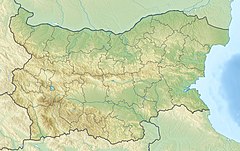Bacho Kiro cave
пещера Бачо Киро | |
 Interior of the cave | |
 location in Bulgaria | |
| Location | canyons of the Andaka and Dryanovo River, near Dryanovo town |
|---|---|
| Region | Bulgaria |
| Coordinates | 42°56′48″N 25°25′49″E / 42.94667°N 25.43028°ECoordinates: 42°56′48″N 25°25′49″E / 42.94667°N 25.43028°E |
The Bacho Kiro cave (Bulgarian: пещера „Бачо Киро“) is situated 5 km (3.1 mi) west of the town Dryanovo, Bulgaria, only 300 m (980 ft) away from the Dryanovo Monastery. It is embedded in the canyons of the Andaka and Dryanovo River. It was opened in 1890 and the first recreational visitors entered the cave in 1938, two years before it was renamed in honor of Bulgarian National Revival leader, teacher and revolutionary Bacho Kiro. The cave is a four-storey labyrinth of galleries and corridors with a total length of 3,600 m (11,800 ft), 700 m (2,300 ft) of which are maintained for public access and equipped with electrical lights since 1964. An underground river has over time carved out the many galleries that contain countless stalactone, stalactite, and stalagmite speleothem formations of great beauty. Galleries and caverns of a 1,200 m (3,900 ft) long section have been musingly named as a popular description of this fairy-tale underground world. The formations succession: Bacho Kiro’s Throne, The Dwarfs, The Sleeping Princess, The Throne Hall, The Reception Hall, The Haidouti Meeting-Ground, The Fountain and the Sacrificial Altar.[1][2]
The site has yielded the oldest human remains ever to be found in Bulgaria. Among one of the earliest known Aurignacian burials (layer 11), two pierced animal teeth were found and ordered into the distinct Bachokiran artifact assemblage. Radiocarbon dated to over 43,000 years ago, they currently represent the oldest known ornaments in Europe.[3] With an approximate age of 46,000 years,[4] human fossils consist of a pair of fragmented mandibles including at least one molar. Whether these early humans were in fact Homo sapiens or Neanderthals was disputed[5][6] until morphological analysis of a tooth and mitochondrial DNA of bone fragments established that remains were those of Homo sapiens. In samples F6-620 and AA7-738 identified mitochondrial haplogroup M, in samples WW7-240 and CC7-335 determined the mitochondrial haplogroup N, in sample CC7-2289 identified mitochondrial haplogroup R, in sample of BK-1653 identified mitochondrial haplogroup U8.[7][8]
A study on remains found at Bacho Kiro cave concluded that Upper Palaeolithic humans had Neanderthal ancestry, which corroborates the link between the earliest modern humans in Europe and later people in Eurasia.[9]
See also[]
| Wikimedia Commons has media related to Bacho Kiro cave. |
- Bohunician
- Dryanovo Monastery
References[]
- ^ "Bacho Kiro Cave Bulgaria - Travel Guide, Tours, Hotels and Photos". Picturesofbulgaria.com. Retrieved January 24, 2017.
- ^ "Spelunking Bulgaria: The Great Caves - GMTours". Gmtours.com. 29 November 2015. Retrieved January 24, 2017.
- ^ Milisauskas, Sarunas (1974). European Prehistory: A Survey. Springer. ISBN 978-1-4419-6633-9. Retrieved June 8, 2012.
One of the earliest dates for an Aurignacian assemblage is greater than 43,000 BP from Bacho Kiro cave in Bulgaria ...
- ^ Fewlass, Helen; Talamo, Sahra; Wacker, Lukas; Kromer, Bernd; Tuna, Thibaut; Fagault, Yoann; Bard, Edouard; McPherron, Shannon P.; Aldeias, Vera; Maria, Raquel; Martisius, Naomi L.; Paskulin, Lindsay; Rezek, Zeljko; Sinet-Mathiot, Virginie; Sirakova, Svoboda; Smith, Geoffrey M.; Spasov, Rosen; Welker, Frido; Sirakov, Nikolay; Tsanova, Tsenka; Hublin, Jean-Jacques (2020-05-11). "A 14 C chronology for the Middle to Upper Palaeolithic transition at Bacho Kiro Cave, Bulgaria". Nature Ecology & Evolution. 4 (6): 794–801. doi:10.1038/s41559-020-1136-3. ISSN 2397-334X. PMID 32393865. S2CID 218593433. Retrieved 2020-05-11.
- ^ Sale, Kirkpatrick (2006). After Eden: The evolution of human domination. Duke University Press. p. 48. ISBN 0822339382. Retrieved 11 November 2011.
- ^ Kuhn, S. L.; Stiner, M. C.; Reese, D. S.; Güleç, E. (2001). "Ornaments of the earliest Upper Paleolithic: New insights from the Levant - THE EVOLUTIONARY SIGNIFICANCE OF EARLY ORNAMENTS". Proceedings of the National Academy of Sciences of the United States of America. PNAS. 98 (13): 7641–7646. doi:10.1073/pnas.121590798. PMC 34721. PMID 11390976.
- ^ Hublin, Jean-Jacques; Sirakov, Nikolay; Aldeias, Vera; Bailey, Shara; Bard, Edouard; Delvigne, Vincent; Endarova, Elena; Fagault, Yoann; Fewlass, Helen; Hajdinjak, Mateja; Kromer, Bernd; Krumov, Ivaylo; Marreiros, João; Martisius, Naomi L.; Paskulin, Lindsey; Sinet-Mathiot, Virginie; Meyer, Matthias; Pääbo, Svante; Popov, Vasil; Rezek, Zeljko; Sirakova, Svoboda; Skinner, Matthew M.; Smith, Geoff M.; Spasov, Rosen; Talamo, Sahra; Tuna, Thibaut; Wacker, Lukas; Welker, Frido; Wilcke, Arndt; Zahariev, Nikolay; McPherron, Shannon P.; Tsanova, Tsenka (2020-05-11). "Initial Upper Palaeolithic Homo sapiens from Bacho Kiro Cave, Bulgaria". Nature. 581 (7808): 299–302. Bibcode:2020Natur.581..299H. doi:10.1038/s41586-020-2259-z. ISSN 1476-4687. PMID 32433609. S2CID 218592678. Retrieved 2020-05-11.
- ^ Roland Knauer (May 11, 2020). "Und Homo sapiens war noch früher da". Spektrum. Retrieved May 14, 2020.
- ^ Mateja Hajdinjak; et al. (2021). "Initial Upper Palaeolithic humans in Europe had recent Neanderthal ancestry". 592. Nature. pp. 253–257. doi:10.1038/s41586-021-03335-3.
- Caves of Bulgaria
- Landforms of Gabrovo Province
- Balkan mountains
- Tourist attractions in Gabrovo Province
- Archaeological sites in Bulgaria
- Limestone caves
- Prehistoric sites in Bulgaria
- History of Gabrovo Province
- Show caves in Bulgaria

